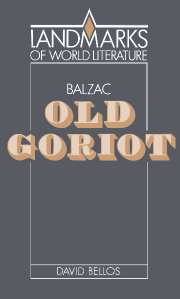1 - The making of Old Goriot
Published online by Cambridge University Press: 05 June 2012
Summary
The novel, the writer, and the reading public
It is hard to imagine a human society of any kind that does not have some way of telling stories. However, the particular form of story-telling that we now call the novel is of relatively recent date, and our present conception of it owes much to Balzac. Before him, of course, long stories written in prose and dealing with imaginary characters had entertained broad audiences for many centuries; but, with rare exceptions, prior to the nineteenth century, novels were considered by writers and readers alike as entertainment and not as part of serious literature, which tended to be restricted principally to drama and verse. The novel, before Balzac, was by no means a simple, homogeneous literary genre, but three main varieties can be identified: picaresque novels, such as Cervantes' Don Quixote or Fielding's Tom Jones, which recount the adventures of a usually male, and usually young, hero in more or less serious conflict with the society he finds himself excluded from; the novel of analysis, such as La Princesse de Clèves by Mme de La Fayette or, on a larger canvas, Rousseau's La Nouvelle Héloise, dealing with the development of characters' inner feelings, most usually in connection with an amorous intrigue; and, in the eighteenth century, the parodic novel – Sterne's Tristram Shandy and Diderot's Jacques le fataliste are the best-known examples of this tradition – which creates sophisticated types of comedy by undermining and parodying the conventions of the picaresque and analytical novels.
- Type
- Chapter
- Information
- Balzac: Old Goriot , pp. 5 - 45Publisher: Cambridge University PressPrint publication year: 1987

